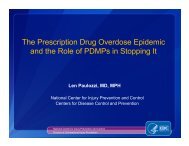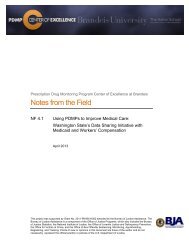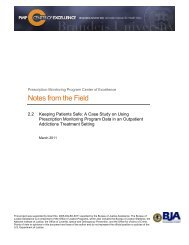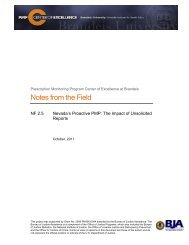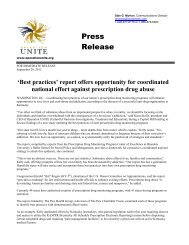Prescription Drug Monitoring Programs - PDMP Center of Excellence
Prescription Drug Monitoring Programs - PDMP Center of Excellence
Prescription Drug Monitoring Programs - PDMP Center of Excellence
You also want an ePaper? Increase the reach of your titles
YUMPU automatically turns print PDFs into web optimized ePapers that Google loves.
<strong>Prescription</strong> <strong>Drug</strong> <strong>Monitoring</strong> <strong>Programs</strong>: An Assessment <strong>of</strong> the Evidence for Best Practices 36Current adoption status: Depending on the state, <strong>PDMP</strong> end users typically include prescribers,dispensers, medical licensing boards, and law enforcement investigators. Some <strong>PDMP</strong>s, however, havewidened their user base to include medical examiners, drug treatment programs and treatmentpr<strong>of</strong>essionals, criminal justice diversion programs such as drug courts, “pre-‐criminal” interventionprograms (<strong>PDMP</strong> COE, NFF, 2.1), and drug prevention initiatives (<strong>PDMP</strong> COE, NFF 3.2). WashingtonState’s new <strong>PDMP</strong> provides data to Medicaid, the Workers’ Compensation unit in the Department <strong>of</strong>Labor and Industries, and the Corrections Department (communication from <strong>PDMP</strong> administrator). A2012 statute authorizes the New York State <strong>PDMP</strong> to provide data to local health departments forpurposes <strong>of</strong> public research and education. Other categories <strong>of</strong> users could include health care systems’peer review organizations (the North Dakota <strong>PDMP</strong> is authorized to provide data to peer revieworganizations) and third-‐party payers’ health care pr<strong>of</strong>essional reviewers.<strong>PDMP</strong>s with more inclusive data access policies can serve as models for programs seeking to expand theiruser base. For example, Kentucky’s <strong>PDMP</strong> permits use <strong>of</strong> its data by drug diversion investigators (<strong>PDMP</strong>COE, NFF 2.3) and drug courts (<strong>PDMP</strong> COE, NFF 2.4), Virginia’s by medical examiners (<strong>PDMP</strong> COE, NFF2.6), and other states by outpatient drug treatment programs (<strong>PDMP</strong> COE, NFF 2.2). A compilation<strong>of</strong> all appropriate end users, developed in consultation with state <strong>PDMP</strong>s and the <strong>PDMP</strong> Training andTechnical Assistance <strong>Center</strong>, would provide direction in maximizing appropriate use <strong>of</strong> <strong>PDMP</strong> data.Developing case studies <strong>of</strong> how data are applied by these end users and in innovative applications (seethe <strong>PDMP</strong> COE “NFF” series) will also assist in moving this process forward.Barriers to adoption: Barriers to permitting greater access to <strong>PDMP</strong> data include the absence <strong>of</strong> specificauthorization for certain users written into a state’s enabling <strong>PDMP</strong> legislation and/or regulations;concerns <strong>of</strong> prescribers and pharmacies about pr<strong>of</strong>essional licensing boards or law enforcement agenciesbeing able to see information about their prescribing and dispensing behavior (sometimes described asfear <strong>of</strong> so-‐called “fishing expeditions” by investigators); concerns about revealing the identity <strong>of</strong> patientsin drug treatment programs; lack <strong>of</strong> <strong>PDMP</strong> resources to undertake outreach and legislative initiatives;and lack <strong>of</strong> awareness <strong>of</strong> <strong>PDMP</strong>s on the part <strong>of</strong> potential end users.SummaryRationale: Permitting and encouraging use <strong>of</strong> <strong>PDMP</strong> data by all appropriate users, and in innovativeapplications, will help to maximize <strong>PDMP</strong> utilization and impact.Evidence <strong>of</strong> effectiveness: Case studies.Current adoption status: States vary in restricting or encouraging use <strong>of</strong> <strong>PDMP</strong> by different categories <strong>of</strong>users.Barriers to adoption: Legislative prohibitions on <strong>PDMP</strong> data access by potential users, concerns aboutmisuse <strong>of</strong> data by law enforcement and substance abuse treatment agencies, lack <strong>of</strong> awareness <strong>of</strong><strong>PDMP</strong>.B. Outreach and recruitment strategiesEnrollment in and use <strong>of</strong> <strong>PDMP</strong>s by medical practitioners is key to achieving their full potential in helpingto ensure safe prescribing and dispensing, and in reducing diversion and abuse <strong>of</strong> controlled substances.



